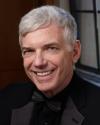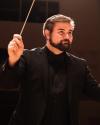Members of the UW Wind Ensemble perform wind music arranged for small ensembles.
Program Detail
Sextet for Piano and Winds (1929) ....................................................Bohuslav Martinů (1890-1959)
I. Preludium
IV. Blues
Kay Yeh, piano
Serenade (2020) .................................................................Katahj Copley (b. 1998)
I. Slow
IV. Dance II
Corey Jahlas, conductor
Sonata for Four Horns, (1952) .....................................................................Paul Hindemith (1895-1963)
I. Fugato
Frippery No. 1 (1964) ....................................................................................Lowell Shaw (b. 1930)
Horn Quartet
Seascape, op. 53 (1958) ............................................................................Ruth Gipps (1921-1999)
Shaun Day, conductor
October (2000) ..........................................................Eric Whitacre (b. 1970) (arr. David J. Miller)
Shaun Day, conductor
Little Threepenny Music (Kleine Dreigroschenmusik) (1929/1975) .................Kurt Weill (1900-1950)
I. Overture
II. The Moritat of Mack the Knife
Va. Polly’s Song
VI. Tango-Ballad
Roger Wu Fu, conductor
Etüde für tiefe Blechbläser im Stile Bruckners ..........................Enrique Crespo (b. 1941)
Trombone Choir
Suite for Harp and Wind Quintet (1951) .................................Chou Wen-Chung (b. 1923)
Kelly Guangyin Hou, harp
Serenade in Eb, op. 7 (1881) .............................................................................. Richard Strauss (1864-1949)
Corey Jahlas, conductor
Masks are required in all indoor spaces on the UW campus. Capacity in Brechemin Auditorium is limited to 100. Proof of vaccination or negative COVID-19 test (within 72 hours of the performance) required. Details of these protocols available here.
Program Notes
Along with Leos Janacek, Bohuslav Martinů was one of the twin giants of Czech music in the twentieth century, a composer with a distinctly individual voice and a versatility that led him to excel in every medium from stage works to symphonies to string quartets – a compositional output of nearly 400 works. Martinů’s Sextet for piano, flute, oboe, clarinet, and two bassoons, written in 1929 during the composer’s time in Paris, reveals a French-influenced neoclassical style with the rhythmic energy of jazz and Central European folk music.
According to composer Katahj Copley, the Serenade for Wind Nonet is intended to be programmatic, depicting the growth of a person out of heartbreak and into a new relationship. The opening movement reflects fresh heartbreak through somber melodic lines showcased in the flutes and oboes. The third movement displays a quasi-romantic waltz as new love is found, and the final movement features driving rhythmic passages encouraging the excitement of love and new possibilities. The Serenade deviates from the typical oboe, bassoon, horn, and clarinet instrumentation of other established serenades in the cannon in favor of a large contingent of saxophones, resulting in a tuneful, unique, and charming work.
Lowell Shaw’s volumes of Fripperies are books of lighthearted and easily read jazz horn quartets--yet the challenge of them lies in interpretation. Horn is not typically a jazz instrument, yet Shaw’s treatment of voicing and range in his Fripperies (creating pillowy timbres within the jazz harmonic vernacular) make it seem like the horn was destined for jazz all along. In explaining his Fripperies, Shaw said,“it seemed best to give [my students] some small exposure to particularly the eighth-note patterns that are so different from what we had experienced in the Kopprasch [etude] books. My aim was to give them some idea where those pesky final off-the-beat eights fall within the uneven swing notation.”
Sonata for Four Horns is deeply rooted in postwar expressionism, containing harmonies evocative of deep turmoil struggling for power over a peaceful solace. This work, three movements in length, summates to be a large tone poem concluding with variations on an old German song “Ich Schell mein Horn”. Movement 1, Fugato, sees the entrance of each horn player over the opening measures, building a lusciously abrasive harmonic trajectory resolving to a resounding E minor statement. Paul Hindemith was an advocate for the concept of Gebrauchsmusik – or “music for use” – and wrote Sonata for Four Horns specifically for the Salzburg Horns.
Ruth Gipps was an English composer, as well as an accomplished oboist, pianist, educator, and conductor during the mid-late 20th century. As a student of Gordon Jacob and Ralph Vaughn Williams, her compositional influences often rejected the avant-garde styles of serialism and instead made significant use of instrumental color throughout her numerous chamber, orchestral, and choral works. Seascape, Op. 53 is a programmatic work inspired by her trip to a coastal town on the Isle of Thanet in Kent, England, where she describes the sounds of the storm and the sea during her stay at a hotel on the beach.
Eric Whitacre is an American Grammy-winning composer, as well as an accomplished conductor and lecturer. He is known for his numerous choral works and works for wind orchestra that includes his 2000 composition October. This programmatic work portrays the crisp autumn weather and subtle color changes of the season with melodies and harmonies influenced by English composers such as Ralph Vaughan Williams and Edward Elgar. David J. Miller’s brass ensemble arrangement of October was completed for The Barclay Brass and is dedicated to the memory of Betsy Geist.
Kurt Weill’s Little Threepenny Music was first performed in 1928 as the music to Bertolt Brecht play adaptation of John Gay’s work, The Beggar’s Opera. The play has been described both as a political satire of 1920s German society, as well as a socialist critique of the growing capitalist sentiment of the time. Its popularity remained and grew alongside capitalism as a social and industrial framework growing and expanding across the globe. The story follows the character Macheath, or Mack the Knife, and his exploits as a bandit and murderer in Victorian London and its underground network; Weill’s stylistic approach reflects the subject matter in his creative instrumentation with accordion and banjo, as well as liberal use of alto and tenor saxophone for jazz-influenced light-hearted melodic writing. German dance music of the 1920s, which itself was influenced by the growth of jazz and public radio broadcasting in the United States, also plays a pivotal role in informing the compositional forms Weill employs, seen in his structure of movements as fox trots, tangos, or waltzes.
Enrique Crespo’s Bruckner Etude fur das tiefe blech (translated as “Bruckner Etude for the deep metal sheet”), pays tribute to a composer who frequently gives tuba players a leading role in orchestral performances. Crespo wrote this piece, originally for four tubas or trombones, in Bruckner’s style. This arrangement is composed for five trombones and one tuba.
In his early works of the 1940’s and 1950’s, Chou Wen-Chung was grappling with the challenge of fusing the East and West: How can Chinese material be developed with Western techniques yet remain intrinsically Eastern? The solution is found in the Suite for Harp and Wind Quintet which captures the color, mood and emotion implied in the seemingly simple folk material by means of its own transmutation. The work features five traditional Chinese melodies cast in five continuous movements, each of a contrasting character.
Richard Strauss’ Serenade in Eb, op. 7 was written when the composer was only 17 years old. Composed in traditional sonata form, the single-movement Serenade blends the traditionally classical styles of Mozart, Brahms, and Mendelssohn with Strauss’ own burgeoning use of chromaticism and soaring, lyrical melodic lines. Much like Mozart’s Gran Partita, written one hundred years earlier, Strauss’ Serenade employs a force of thirteen wind instruments, utilizing flutes instead of Mozart’s basset horns, and a contrabassoon (or tuba) instead of a contrabass. Audiences will find the Serenade refreshing, familiar, and musically deep and vibrant.
Artist Bios
SOLOISTS
Kay Yeh is currently in her second year as a DMA student under the tutelage of Professor Robin McCabe. She earned her Master's degree in piano performance from the University of Washington in 2015. Prior to coming to Seattle to pursue her passion for piano, Kay's creativity expanded to graphic design and illustration as she earned her Bachelor's degree in Architecture from National Cheng-Kung University in Taiwan.
Kelly Hou has been playing the harp for seven years. She was a part of the Seattle Youth Symphony for four years before enrolling at the University of Washington in 2019 as an Informatics major, and then later joining the University of Washington Wind Ensemble and Symphony Orchestra in 2020 as a music performance major. In the future, Kelly hopes to become a professional harpist and harp teacher, although working at Amazon is always another option. A question that she is often asked is “what made you start playing the harp”? The answer: a picture book about leprechauns playing golden harps, several stressful piano lessons as a child, and a desire to play an instrument that is a full foot taller than her.
THE UNIVERSITY OF WASHINGTON WIND ENSEMBLE
The University of Washington Wind Ensemble has performed at many prestigious music conventions, has presented several world premiere performances of outstanding new music for wind band and in 2004, undertook a highly acclaimed nine-day concert tour of the Kansai region of Japan, returning for more extensive tours of that country in 2007 and 2010. The UW Wind Ensemble presented several concerts in the main concert venues of Beijing, China in March of 2013, including a sold-out concert in the National Center for the Performing Arts in Tiananmen Square that was broadcast nationwide on China Central Television. The ensemble returned to China in both 2016 and 2019, playing before large crowds in Beijing, Shanghai, Xi'an and Chengdu. In the spring of 2006, the ensemble was invited by the Seattle Symphony Orchestra to present a concert at Benaroya Hall as a part of the Symphony’s Made in America
Festival. The London Financial Times review of the concert applauded “music of surprising sophistication…Cindy McTee’s Finish Line pulsated energetically, and William Bolcom’s Song was simply gorgeous.” Following the 2006 performance the ensemble was invited for return appearances on Seattle Symphony concert series in 2007, 2008 and, most recently in 2011 when Maestro Gerard Schwarz conducted the ensemble. The UW Wind Ensemble has collaborated with internationally renowned guest artists, conductors and composers including Eddie Daniels, Steve Houghton, Allen Vizzutti, Jeffery Fair, Chris Olka, James Walker, Douglas Yeo, Leigh Howard Stevens, David Maslanka, Michael Colgrass, Bonnie Whiting, Cindy McTee, Eric Ewazen, Satoshi Yagisawa, David Stanhope, John DiCesare, David Gordon, Mary Lynch, Seth Krimsky, Michael Brockman and Huck Hodge. Nihon Pals, a music education resource company based in Osaka, Japan, released a set of instructional DVDs regarding ensemble musicality featuring the UW Wind Ensemble.
Personnel
UNIVERSITY OF WASHINGTON WIND ENSEMBLE
FLUTE
Tracia Pan, Fr., Music Performance, Bellevue*
Elizabeth Nilles, So., Music Performance/Biology, Camas
Stephanie Chuang, Sr., Computer Science/Cinema and Media Studies, Camas
Carson Chadd, Fr., Music Performance, Marysville
OBOE
Daren Weissfisch, Grad., Orchestral Conducting, Ridgewood, NJ*
Kamill Tarnawczyk, Sr., Physics/Music, Edmonds
Oliver Wang, Jr., undeclared, Hangzhou, Zhejiang, China
BASSOON
Julien Tsang, Grad., Accounting, Kent*
Chloe Person, So., Music History, Kenmore
Nate Chen, So., Computer Science, Vancouver
CLARINET
Khang Zhie Phoong, Sr., Computer Science, Singapore*
Alex Gee, Fr., undeclared, Camas
Conrad Lin, So., Statistics, Boise, ID
Megan Rideout Redeker, Jr., Music Performance, Bainbridge Island
Tyler Roberts, Post Bac., Music Education, Redmond
Mina Hung, Jr., Art & Food System, Nutrition, and Health, Taipei, Taiwan
BASS CLARINET
Emerson Bowles, Jr., Physics, San Diego, CA
SAXOPHONE
Nicholas Franks, Jr., Music Education, Camarillo, CA*
Diego Mesquita, So., Civil Engineering, Bellingham
Lisa Dockendorff, Jr., Society, Ethics, and Human Behavior, Vernon, CT
Katie Zundel, Fr., Music Performance/Engineering, Clinton
TRUMPET
Shaun Day, Grad., Wind Conducting, Cincinnati, OH*
Zach Griffin, So., Music Performance, Bothell
Carlos Alvarez, So., undeclared, Kirkland
Caroline Kelly, Music Performance/Environmental Science, Chelan
Colton Lindstrand, So., Biology, Marysville
Brandon Cain, Jr., Music Education, Graham
Jennifer Stump, So., undeclared, Lynnwood
HORN
Anna Perry, Grad., Music Performance, Hilliard, OH*
Nicholas Hidy, Grad., Music Performance, Sebastopol, CA
Maia Willebrand, So., Aeronautics and Astronautics, Puyallup
Kiyoshi Colon, Fr., Chemistry, Everett
Aaron Anderson, Jr., Music Performance, Tigard, OR
TROMBONE
Neal Muppidi, So., Physics/Music, Austin, TX*
Sean Grimm, Sr., Statistics, Vancouver
Jonathan Elsner, Jr., Mathematics, Kent
Alberto Macias, Jr., Psychology, Yakima
Clayton Thomas, Sr., Electrical Engineering, Kenmore
EUPHONIUM
Corey Jahlas, Grad., Wind Conducting, Highland, MI
Ethan Walker, So., Music Education, Kenmore
TUBA
Ben Berlien, community member, Seattle*
Roger Wu Fu, Grad., Wind Conducting, Santiago, Chile
BASS
Beau Wood, Sr., Music Performance, Longview
PERCUSSION
Scott Farkas, Grad., Music Performance, Twin Falls, ID*
Abigail George, So., Music Performance, Redmond
Nina Okubo, So., undeclared, Yakima
Brindha Jaeger, Fr., Music Performance/Environmental Science, Stanford, CA
Simon Harty, Fr., undeclared, Boise, ID
Ryan Baker, So., Music Performance, Gig Harbor
PIANO
Yen-Chun (Kay) Yeh, Grad., Music Performance, Chaiyi, Taiwan
HARP
Kelly Guangyin Hou, So., Music Performance/Informatics, Bellevue
GRADUATE STUDENT CONDUCTORS
Shaun Day, Grad., Wind Conducting, Cincinnati, Ohio
Corey Jahlas, Grad., Wind Conducting, Highland, MI
Roger Wu Fu, Grad., Wind Conducting, Santiago, Chile
*principal

University of Washington Professor Emeritus Timothy Salzman served as Professor of Music/Director of Concert Bands and conductor of the UW Wind Ensemble from 1987 to 2025. When he was appointed to the position there were 11 students enrolled in one UW wind band – in his final year there were 335 enrolled in five bands. Former graduate wind conducting students of Professor Salzman have obtained positions at 73 universities and colleges throughout the United States and include past presidents of the American Bandmasters Association and the College Band Directors National Association as well as Jiannan Cheng, Assistant Conductor of the Baltimore Symphony Orchestra. During his tenure at the UW the band program was involved in commissioning and, in certain cases, the premiering of 38 new works for wind ensemble and undertook many concert tours including seven to Asia. From 1978 to 1983 he was band director in the Herscher, Illinois, public school system where the band program received numerous state, regional and national awards in solo/ensemble, concert and marching band competition. Immediately prior to his UW appointment he served for four years as Director of Bands at Montana State University where he founded the MSU Wind Ensemble and ‘Spirit of the West’ Marching Band. Professor Salzman holds degrees from Wheaton (IL) College, and Northern Illinois University, and studied privately with world-renown wind instrument pedagogue Arnold Jacobs, former tubist of the Chicago Symphony Orchestra. He has numerous publications for bands with the C. L. Barnhouse, Arranger's Publications, Columbia Pictures, Hal Leonard Publishing and Nihon Pals publishing companies, and has served on the staff of new music reviews for The Instrumentalist magazine. Professor Salzman has been a conductor, adjudicator, arranger, or consultant for bands throughout the United States and in Canada, England, France, Russia, South Korea, Indonesia, Thailand, Singapore, the Philippines, China, and Japan, a country he has visited twenty-one times. He has traveled to China twelve times where he served as visiting professor at the China Conservatory, given master classes for numerous wind bands, and conducted several ensembles including the Shanghai Wind Orchestra, the People's Liberation Army Band, the Beijing Wind Orchestra, The China Conservatory Wind Ensemble and the Tsinghua University Band in multiple concerts. He also served on three occasions as an adjudicator for the Singapore Youth Festival National Concert Band Championships. He has conducted several of the major military bands in the United States including a 2019 world premiere with 'The President's Own' United States Marine Band. He was compiling editor and co-author (with several current and former UW graduate students) of A Composer's Insight: Thoughts, Analysis and Commentary on Contemporary Masterpieces for Wind Band, a five-volume series of books on contemporary wind band composers. The forwards to each volume were written by five Pulitzer Prize-winning composers. He was also a contributing author to a recent book (2022) about his former teacher entitled Arnold Jacobs: His Artistic and Pedagogical Legacies in the 21st Century. Professor Salzman is an elected member of the American Bandmasters Association and is a past president of the Northwest Division of the College Band Directors National Association. He is an elected member of the Drum Corps International Hall of Fame as well as the Santa Clara (CA) Vanguard and Cavaliers (IL) Drum and Bugle Corps Hall(s) of Fame for his work as an arranger and brass instructor. In 2009 Nihon Pals, a music education resource company based in Osaka, Japan, released a set of instructional DVDs regarding ensemble musicality featuring the UW Wind Ensemble. The University of Washington hosted the 2011 National Conference of the College Band Directors National Association.

As a conductor, trumpet player, and educator, Shaun Day enjoys sharing his passion by working with a variety of music ensembles and creating a positive community through music. Shaun is completing his DMA in Instrumental Conducting at the University of Washington where he is the director and conductor for the UW Symphonic Band, and the associate conductor for the UW Wind Ensemble. He is also serving as the Conductor and Artistic Director for the Mukilteo Community Orchestra and enjoys connecting with local music educators in the Seattle area. Shaun continues to work as an ensemble clinician, guest conductor, and as a presenter at music education conferences, including the Washington Music Educators Association (WMEA) State Conference.
Originally from Cincinnati, Ohio, Shaun earned his BM in Music Education with a concentration in trumpet performance, and his MM in Conducting from the University of Cincinnati, College-Conservatory of Music (CCM). During that time, he was the manager of the CCM Wind Symphony, CCM Brass Choir, the University Commencement Band, and a Graduate Assistant of the University of Cincinnati Bearcat Band. Shaun also served as the Associate Conductor of the University of Cincinnati Symphony Orchestra and Guest Conductor for the Fillmore Philharmonic Brass (OH).
Before completing his MM, Shaun was the assistant band director at Turpin High School in Cincinnati. His duties included directing the high school concert bands, directing the high school jazz program, the musical theatre pit orchestra, assisting and directing the high school marching band program, and directing the 5th-12th concert bands. His professional affiliations include the College Band Directors National Association (CBDNA), Washington Music Educators Association (WMEA), and the Ohio Music Education Association (OMEA) where he served as the District XIV Secretary and Treasurer from 2016-2018.

Originally from Highland, MI, Corey Jahlas is in his first year of the Doctor of Musical Arts and Instrumental Conducting program at the University of Washington, where he serves as a Graduate Student Conductor of the Husky Athletic Bands, co-conductor of the Campus Band, and assistant conductor of the Wind Ensemble.
Most recently, Corey earned his Master of Music in Wind Conducting from Central Michigan University, studying with Prof. Jack Williamson. There, he instructed the 280-member Chippewa Marching Band and served as the instructor on record for the Symphony Band and the University Band. Prior to his Master’s work, Corey taught from 2014-2017 in Oxford, MI, leading the middle school band program, the OMS Percussion Ensemble, and assisting with the OHS Wildcat Marching Band.
Corey also holds degrees in Music Education and Music Theory and Composition from Central Michigan, where he studied euphonium with Dr. Mark Cox and composition with Dr. David Gillingham. Sharing his love for the marching arts, Corey served as Assistant Director of the Madison Scouts Drum and Bugle Corps in 2014, having marched with the group in 2011. He also serves as a clinician, arranger, and drill writer for high schools and university marching bands in Michigan, Ohio, Pennsylvania, and New Hampshire, and is the Director of the Drum Major Camp at Central Michigan University. Corey holds memberships in the National Association for Music Education, Pi Kappa Lambda, Phi Mu Alpha Sinfonia, and Kappa Kappa Psi.

M.M Wind Conducting, Peabody Institute of the Johns Hopkins University, 2020
M.Ed. Education, Concordia University Irvine, 2018
B.A. Anthropology, University of California Los Angeles, 2014
Recent works include producing and music directing his original musical “Yappie: The Musical” and its concept album premiere, music directing chamber operas exploring the relationship between growth and suffering in Baltimore’s contemporary opera scene, and presenting research on instrument pedagogy, choice, and personality at Ohio State University. At the Peabody Institute of the Johns Hopkins University, Roger worked as a conductor, performer, teaching assistant and faculty substitute. Through summer conducting workshops, Roger has worked with conductors including Dr. Travis Cross, Dr. Mallory Thompson, Professor Charles Peltz, Dr. Cynthia Johnston Turner, Dr. Mark Scatterday, Professor Kevin McKeown and Dr. Mitchell Fennell. Drawing from his own varied background studying anthropology at the University of California, Los Angeles, and Wind Conducting at Peabody Institute of the Johns Hopkins University, Roger seeks to combine a high standard of musical performance with a rigorous academic approach, always seeking to explore and present music in a new and different light.
Outside of music, Roger works with the mental health foundation Healthy Gamer by providing peer-delivered recovery support services as a group and personal coach. In his offtime, Roger enjoys being a mediocre cook, catching up on popular shows from half a decade ago, and biking. Roger is extremely excited to join the Husky family at UW, and get to know the PNW at large - Go Dawgs!
